Application Specific Automotive Analog IC Market Size
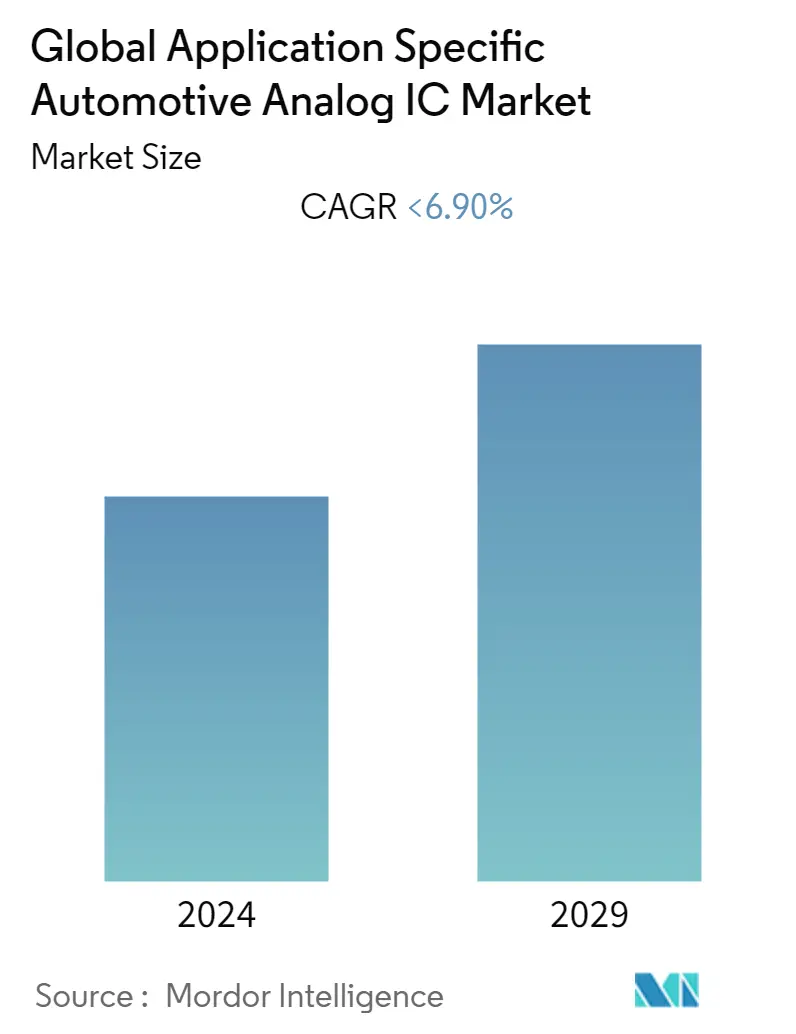
| Study Period | 2019 - 2029 |
| Base Year For Estimation | 2023 |
| CAGR | 6.90 % |
| Fastest Growing Market | North America |
| Largest Market | Asia-Pacific |
| Market Concentration | Medium |
Major Players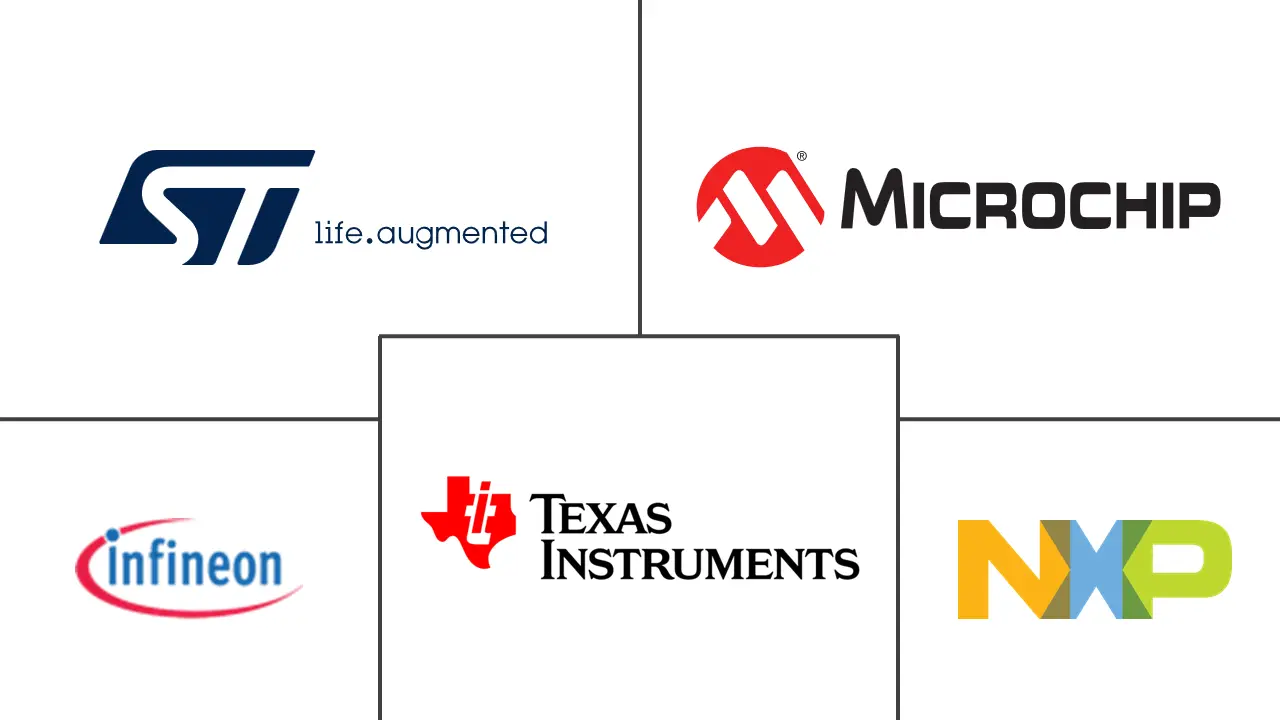
*Disclaimer: Major Players sorted in no particular order |
Application Specific Automotive Analog IC Market Analysis
The global application-specific automotive analog IC market is expected to register a CAGR of 6.9% from 2022 to 2027. The market refers to different integrated circuit (IC) chips facilitating various sensors and other purposes. Since each IC chip serves a specific purpose in various automotive products, it creates a demand for mass production. This forms a market comprising industries dedicated to manufacturing and investing resources in the constant evolution and optimization of such application-specific analog ICs.
- Analog ICs refer to the IC deployed with sensors, input transducers, and signal processors and converters. These ICs convert the analog signals into digital values and vice-versa, which are programmable and exchange data with the central processing units for further processing. The interface between the environmental factors and the central processing units inside an automotive vehicle is facilitated by the sensors in analog ICs for specific usage.
- Recent times have seen a rise in the development and adoption of autonomous and semi-autonomous vehicles. This development in the self-driving or drive-assist features could be possible by leveraging the options available for sensing the environment. The rapid growth in analog ICs, with new-age sensors like ultrasonic sensors, RADARs, LIDARs, etc., could make real-time monitoring of the surroundings realistic. The fast processing and transfer of information from these ICs could facilitate a more immediate response, ensuring the safety of the passengers and the pedestrians.
- The evolution of analog ICs for automotive applications has benefitted different applications, like infotainment systems, vehicular handling and dynamics, power management, powertrains controls, safety solutions, IoT remote connected features, etc. Such features incorporate different ICs dedicated to specific functions to carry out networking among different sections of vehicular operation.
- The safety advancements achieved through features like Electronic Stability Program (ESP), ABS, EBD, lane-keep assist, electronic brake assist, etc., are some of the features that are being made compulsory for automotive manufacturers to include in their offerings. The introduction of such regulations is driving the analog IC market for constant upgradation, optimization, and faster data processing rates, to minimize the response time and maximize safety. The precision of such systems is enhanced with the advancement in analog ICs used for each safety feature.
- The covid-19 pandemic demanded the manufacturers shift focus to fulfill the demand for remote-working essentials. Companies opting for work-from-home and international lockdowns focused on consumer electronics items, affecting industries, including analog IC manufacturing. Car-making factories remained shut down due to a lack of workforce movement, which decreased the production of analog ICs for automotive requirements. The supply chain disruption created then in the analog IC industry is still in the recovering phase, pushing the lead times further for the automotive manufacturers.
Application Specific Automotive Analog IC Market Trends
This section covers the major market trends shaping the Application Specific Automotive Analog IC Market according to our research experts:
IoT- And Sensor-Based Features in Automobiles Driving the Market
- The global automotive market is witnessing the introduction of new-age features in automobiles. The development of cloud infrastructure and connected-car technologies has seen a rise in recent times, finding new ways to enhance automobile customer experience and safety. Such features require an interface between the real world and digital processing. Analog circuits on IC chips facilitate the same and are getting involved in automotive manufacturing on a broader scale.
- Cars these days comprise autonomous and semi-autonomous features. The self-driving vehicles manufactured by carmakers like Tesla are gaining popularity. The functionality is achieved by leveraging more than one sensor technology for capturing the environment that drives the powertrain and steers the vehicle accordingly. The new software optimization requires hardware optimization that pushes the technological advancements in automotive analog ICs. IC manufacturers deploy new robust and precise architectures to ensure cutting-edge accuracy of inputs despite a harsh environment.
- Electronic aids like ABS, EBD, ESP, electronic brake-assist, hill-descend control, and hill-hold assist prove to be life-saving. These require faster response times for the system to engage the counteraction and direct the vehicles accordingly. This need for efficiency is also driving the advancements in analog ICs. Many companies are offering such features as standard or as optional add-ons. It is observed how such features report safeguarding both the passengers and the pedestrians on roads. Thus, governments are announcing such features to be mandatory in cars to ensure road safety and public well-being.
- The transition of internal combustion engines to electrification is going through mild hybrid systems alongside pure EV development. Both the systems demand power management, which deploys analog IC for managing the power efficiently. Also, the motor drivers for electric systems running on voltages like 48V create demand for motor drivers. The same might be the case with power regeneration and battery management systems deployed in electric vehicles playing vital roles in efficient charge management.
- Companies are developing new solutions by deploying analog ICs for solutions like telematics and connected car features. Companies offer remote-controlled features like geofencing, vehicular diagnostics, driving behavior observations for utilities like insurances, etc. New start-ups are coming up with plug-and-play solutions that enable smart functionality in vehicles by connecting them with the internet. Such features being deployed as after-market solutions or directly through OEMs create demand for sensor-based execution, providing IoT-based features to the users.
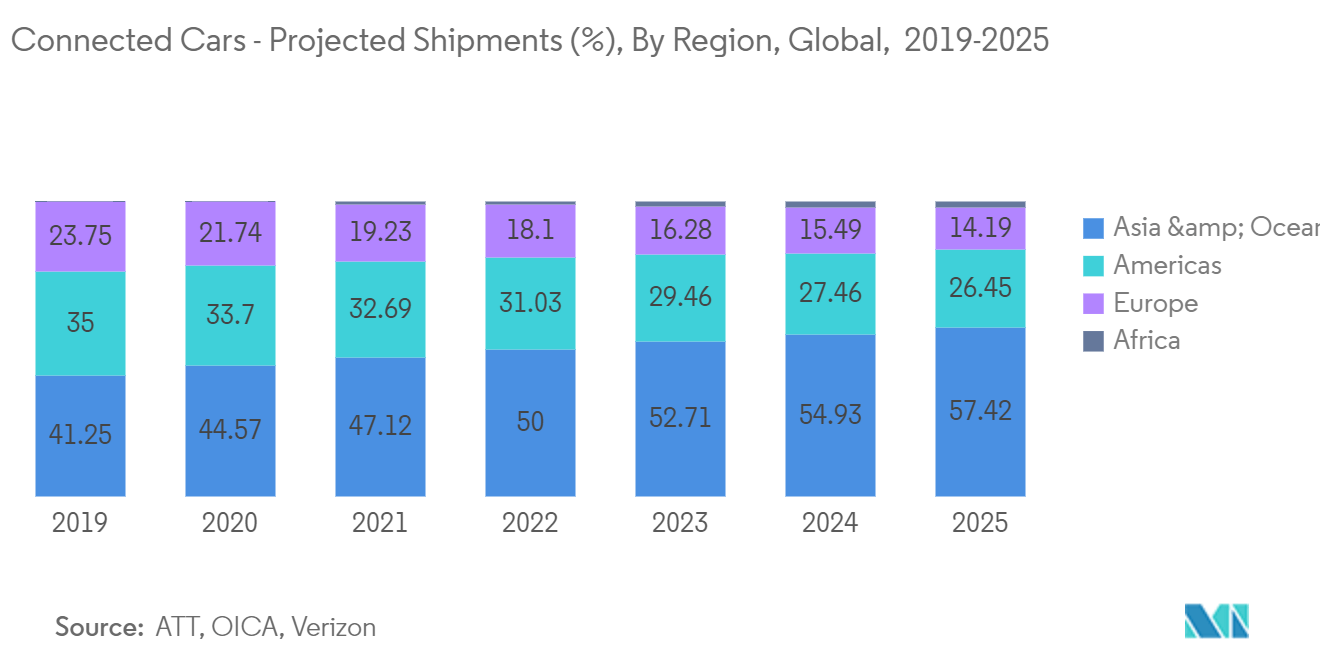
Asia-Pacific to Show Fastest Growth, Driving the Market
- The Asia-Pacific region will register the maximum growth in the demand for analog IC in automotive applications. The region is undergoing development in terms of road safety and infrastructure development to enhance road safety. The majority of the automakers are introducing new vehicles equipped with sensor-based guidance systems for improving road and pedestrian safety in the region.
- The governments are updating the road safety norms, making certain electronic safety aids mandatory in passenger vehicles. For instance, the Indian government made ABS compulsory for two-wheelers and driver-side airbags mandatory in the country. Both the features utilize wheels sensor and pressure sensor, respectively, making room for respective analog ICs for improved response. Similarly, other countries are enforcing certain restrictions on carmakers to include
- The introduction of electric vehicles and fast adoption among major giants like China and India will invite applications like power managing analog ICs and motor driving ICs. The region is yet to welcome large chains of charging stations featuring fast chargers, incorporating power management solutions for efficient, fast, and safe power transfer. Similarly, converting ICs for power management will be demanded for installations in cars.
- The improvement and upscaling of 4G and 5G connectivity in various parts of Asia is driving the incorporation of connected car features in vehicles. This is also paving the way for autonomous transit options, encouraging the use of sensor-based convenience and safety features in automobiles. The region will witness growth in telematics and remote vehicular surveillance technologies, incorporating more sensor-based monitoring for vehicular health, commercial, and general safety purposes.
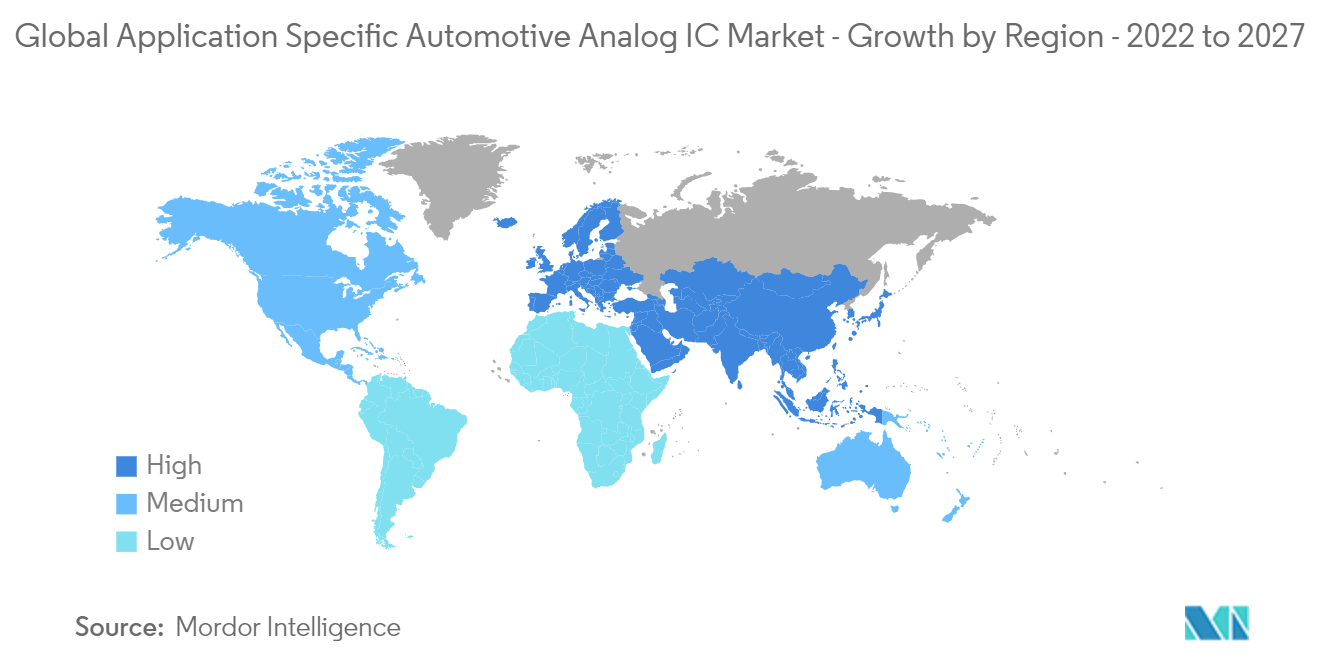
Application Specific Automotive Analog IC Industry Overview
The constantly evolving market space of application-specific analog IC for the automotive market shows moderate to high-intensity competition. The market comprises major electronic manufacturing companies, offering solutions specific to automotive applications. The high setup costs keep the new entrants from entering the space. However, local OEM suppliers are constant threats coming up with the evolving products as per market requirements.
- May 2021 - Analog Devices Inc (ADI) expanded the battery management system (BMS) product portfolio, which includes ASIL-D functional safety and innovative new low-power features, enabling constant battery monitoring function. The new devices differentiate ADI's BMS platform, which delivers high accuracy. The platform supports significant battery chemistries, including zero-Cobalt LFP (lithium iron phosphate), which is used for mass-market electric vehicles (EVs), and energy storage systems (ESS) used for the reuse and recycling of battery packs.
- February 2022 - NXP Semiconductors launched the S32G GoldVIP, addressing software-defined vehicles' real-time and application development challenges using S32G vehicle network processors. This vehicle integration platform allows users to observe S32G performance readily, with real-time use cases and resource monitoring. Combined with the S32G Reference Design Board (RDB2) or GoldBox Service-oriented Gateway reference design, The solution allows the users to deploy rapid product prototypes for desktop, lab, and in-vehicle applications combined with the S32G Reference Design Board (RDB2) or GoldBox Service-oriented Gateway reference design.
Application Specific Automotive Analog IC Market Leaders
-
Infineon Technologies AG
-
Microchip Technology Inc.
-
NXP Semiconductors N.V.
-
STMicroelectronics N.V.
-
Texas Instruments Incorporated
*Disclaimer: Major Players sorted in no particular order
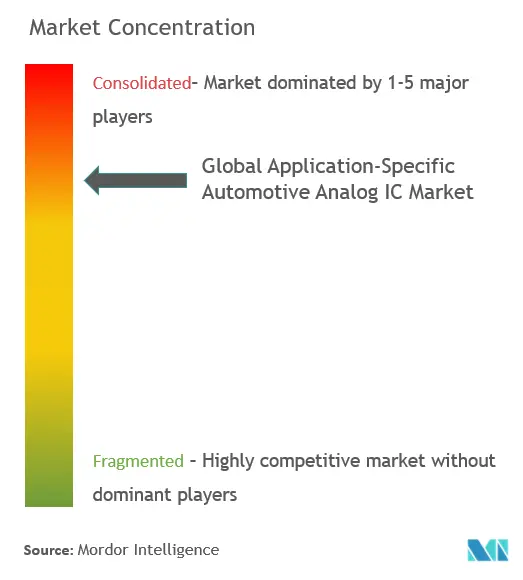
Application Specific Automotive Analog IC Market News
- May 2022 - Texas Instruments introduced solid-state relays' portfolio, comprising automotive-qualified isolated drivers and switches, making EVs safer. The TPSI3050-Q1 isolated switch driver with an integrated 10-V gate supply and the TPSI2140-Q1 1,400-V, 50-mA isolated switch are the solutions introduced. These provide integration of power and signal isolation across a single barrier, adding to the reliability of the new approach, contrary to the conventional electromagnetic relays and solid-state photo-relays. The latest drivers can reduce the solution size up to 90%. It helps lower the Bill-of-materials (BOM) cost of powertrain and 800-V battery-management systems, offering excellent reliability.
- May 2022 - NXP Semiconductors N.V. announced the expansion of its Trimension product portfolio to combine ultra-wideband (UWB) radar and fine ranging capabilities, enabling high motion sensitivity for presence detection, vital signs monitoring, and gesture recognition. The expansion includes Trimension SR160, which can be used to protect against hot car incidences. Such incidences require sending safety alerts when a child is sent in the backseat.
Application Specific Automotive Analog IC Market Report - Table of Contents
1. INTRODUCTION
- 1.1 Study Assumptions
- 1.2 Scope of the Study
2. RESEARCH METHODOLOGY
3. EXECUTIVE SUMMARY
4. MARKET INSIGHTS
- 4.1 Market Overview
-
4.2 Industry Attractiveness - Porter's Five Forces Analysis
- 4.2.1 Threat of New Entrants
- 4.2.2 Bargaining Power of Buyers
- 4.2.3 Bargaining Power of Suppliers
- 4.2.4 Threat of Substitutes
- 4.2.5 Intensity of Competitive Rivalry
5. MARKET DYNAMICS
-
5.1 Market Drivers
- 5.1.1 Increasing Applications of Internet of Things (IoT)
- 5.1.2 Rapid Electrification of Automobiles
- 5.1.3 Growing Adoption of Remote Real-Time and Sensor-Based Features
-
5.2 Market Restraints
- 5.2.1 Increasing Design Complexity with Increasing Applications
- 5.2.2 Constant Evolution of Products Influencing Demand
- 5.3 Covid-19 Impact on the Market
6. MARKET SEGMENTATION
-
6.1 Segmentation - By Geography (Market Estimations and Projections along with Volume Data)
- 6.1.1 North America
- 6.1.2 Europe
- 6.1.3 Asia-Pacific
- 6.1.4 Rest of the World
7. COMPETITIVE LANDSCAPE
-
7.1 Company Profiles
- 7.1.1 Infineon Technologies AG
- 7.1.2 NXP Semiconductors NV
- 7.1.3 Texas Instruments Inc.
- 7.1.4 Microchip Technology Inc.
- 7.1.5 Qualcomm Inc.
- 7.1.6 Maxim Integrated Products Inc.
- 7.1.7 STMicroelectronics NV
- 7.1.8 Richtek Technology Corporation
- 7.1.9 Taiwan Semiconductor Co., Ltd.
- 7.1.10 Skywork Solutions Inc.
- *List Not Exhaustive
8. MARKET OPPORTUNITIES AND FUTURE TRENDS
** Subject To AvailablityApplication Specific Automotive Analog IC Industry Segmentation
Application-specific automotive analog IC market refers to the market of integrated circuits serving specific purposes, with analog inputs, depending upon the type of ICs considered. The automotive industry has numerous areas of application of analog ICs, deploying specific sensors for achieving particular sets of respective functions. The market is segmented geography. The report covers market estimations and projections along with volume data.
| Segmentation - By Geography (Market Estimations and Projections along with Volume Data) | North America |
| Europe | |
| Asia-Pacific | |
| Rest of the World |
Application Specific Automotive Analog IC Market Research FAQs
What is the current Global Application Specific Automotive Analog IC Market size?
The Global Application Specific Automotive Analog IC Market is projected to register a CAGR of less than 6.90% during the forecast period (2024-2029)
Who are the key players in Global Application Specific Automotive Analog IC Market?
Infineon Technologies AG, Microchip Technology Inc., NXP Semiconductors N.V., STMicroelectronics N.V. and Texas Instruments Incorporated are the major companies operating in the Global Application Specific Automotive Analog IC Market.
Which is the fastest growing region in Global Application Specific Automotive Analog IC Market?
North America is estimated to grow at the highest CAGR over the forecast period (2024-2029).
Which region has the biggest share in Global Application Specific Automotive Analog IC Market?
In 2024, the Asia-Pacific accounts for the largest market share in Global Application Specific Automotive Analog IC Market.
What years does this Global Application Specific Automotive Analog IC Market cover?
The report covers the Global Application Specific Automotive Analog IC Market historical market size for years: 2019, 2020, 2021, 2022 and 2023. The report also forecasts the Global Application Specific Automotive Analog IC Market size for years: 2024, 2025, 2026, 2027, 2028 and 2029.
Global Application Specific Automotive Analog IC Industry Report
Statistics for the 2024 Global Application Specific Automotive Analog IC market share, size and revenue growth rate, created by Mordor Intelligence™ Industry Reports. Global Application Specific Automotive Analog IC analysis includes a market forecast outlook to 2029 and historical overview. Get a sample of this industry analysis as a free report PDF download.



